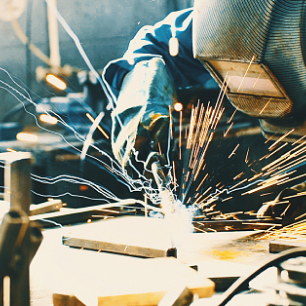Jump to:
Setting the Standard for Handheld Laser Welding
The aerospace industry demands precision in manufacturing, often with thin, lightweight materials that are prone to distortion and burn-through. Opportunities to improve the welding process and throughput are always top of mind in this sector. For this reason, some aerospace manufacturers are considering or have become early adopters of handheld laser welding.
This welding process is quickly charting new territory. However, manufacturers currently lack AWS specifications for handheld laser beam welding. Guidance for handheld laser welding in the aerospace industry is being drafted by the AWS D17 Committee on Welding in the Aircraft and Aerospace Industry from auto-mated laser welding specifications, insights, and best practices from early-adopting manufacturers. These manufacturers are reporting several benefits of handheld laser welding: ease of use for the workforce not formally trained in traditional welding processes, cost and time savings, and reduced distortion. Given the new technology, safety is also a top priority.
Labor Market Benefits for Aerospace Manufacturers
Aerospace manufacturers and defense contractors require welding operators to meet strict production schedules. The ongoing labor shortage continues to affect the welding industry, with an estimated 82,500 welders needed annually through 2028 (weldingworkforcedata.com). Manufacturers attempt to fill the gaps by scouting talent at trade schools, utilizing workforce companies to attract welders, and supplementing skilled laborers with cobots and automation.
Handheld laser welding can open the labor market for manufacturers because it reduces the learning curve for beginning welders. Technology makes this new technique less complicated than traditional welding processes, where multiple factors (contact tip to work distance, angles, travel speed, and filler metal feed) must be met for a quality weld. Handheld laser welding offers a simpler approach, with drag tip design and wire feeding that controls the travel speed. Beginner welders can get up and running in hours vs. weeks. This easier-to-use, efficient technology is ideal for the aerospace manufacturing sector.
Cost and Time Savings for Aerospace Manufacturers
Considering high inflation, rising capital costs, and steep competition faced by the aerospace industry, equipment and labor costs are always a concern for these manufacturers. The expense of automated systems can be a barrier to small and midsize businesses. However, handheld laser welding units can be purchased for a fraction of the cost of traditional automated laser systems and don’t require the added expense of having programmers and engineers on staff. Due to the ease of use of handheld laser welding units, manufacturers can expand their business capabilities by employing beginner welders so that highly skilled welding talent can be retained for more-complicated applications.
Handheld laser technology also drastically reduces cleanup time for aerospace manufacturers. The precision of laser welding, along with built-in pre- and postwelding cleaning capabilities in some welding machines, can dramatically decrease production time. For example, a manufacturer who introduced the technology into its operation said its postwelding cleanup and straightening dropped from two days to two hours. Laser welding is also inherently more efficient and productive, with 1000 times the power density of traditional arc welding, which leads to higher travel speeds.
By virtue of precision, handheld laser welding can efficiently replace the traditional labor-intensive intermittent welding process. One manufacturer that had previously measured and marked intermittent welds achieved a 50% reduction in weld prep time using handheld laser welding, along with the ability to weld the entire piece and eliminate setup time. The manufacturer anticipated cutting the entire operational timeline in half by replacing intermittent welding with handheld laser welding.
Reduced Distortion in Aerospace Manufacturing
The thin, lightweight materials commonly used in the aerospace industry are susceptible to distortion if not welded correctly. Because laser welding typically results in less heat input than arc welding, part distortion is minimized. Here are a few examples of how handheld laser welding reduced distortion for aerospace manufacturers and defense contractors, ultimately increasing their productivity.
A private space company switched from gas tungsten arc welding to handheld laser welding on its spacecrafts, allowing it to use thinner and less weld material. This allowed for more payloads (e.g., satellites) to be sent into space, increasing profitability.
A defense contractor whose parts were distorting and shrinking from arc welding had to hand-drill hundreds of holes to meet tolerance for the job. By substituting handheld laser welding, the manufacturer was able to automate the drilling of the holes due to lack of distortion; it was also quite surprising that a beginner welder could complete the task.
A manufacturer that used arc welding was able to eliminate burn-through and greatly reduce the use of adhesives, which pose fume and cleanup hazards, by implementing handheld laser welding.
Safety in Aerospace Handheld Laser Welding
Safety is an integral component of welding, regardless of the specific process used. For handheld laser welding, there are notable safety considerations to be aware of before implementing this process. Handheld laser welding units are best when equipped with several safety functions that protect operators and passersby. Some units come equipped with built-in safety features, including the following:
Back-reflection sensing, which shuts down the machine if the laser is reflecting back into the lens, protecting the operator and the system.
Plasma detection, which stops the unit if it is pointed away from the weld piece and doesn’t sense the plasma created by laser welding.
A continuity sense clamp, which requires the torch nozzle and the workpiece to be connected for the unit to activate. In some units, this safety measure also functions during the cleaning process.
The ANSI standard for Class 4 welding lasers requires a staff member at the purchasing company to be certified as a laser safety officer (LSO). The LSO is responsible for ensuring the laser is operated/demonstrated safely by trained personnel and that the environment surrounding the laser welding cell or laser-controlled area is safe for people nearby when the laser is in operation. Handheld laser welding operators must also wear specific laser safety goggles and an appropriate laser-safe helmet that has an additional filter for infrared wavelengths, as determined by the LSO.
In addition, the AWS Safety and Health Committee and the SH4 Subcommittee on Labeling and Safe Practices prepared a new Safety and Health Fact Sheet, No. 46, on Handheld Laser Welding Safety. This is avail-able as a free download at aws.org/standards-and-publications/free-resources.
AWS Specifications
The AWS D17 specifications are industry consensus standards and, therefore, are not required to be used. However, utilizing the standard reduces the liability for manufacturers, which has driven its widespread adoption. In light of significant interest from the North American welding industry, work within D17.1/D17.1M:2024, Specification for Fusion Welding for Aerospace Applications, to account for the use of handheld laser welding units has already begun. Per the AWS process, the task group is drafting recommendations for the specification. The committee will take into account various sources of information, including the existing automated laser welding criteria as well as data from manufacturers who are already testing and using the handheld laser technology in their operations. The process of developing and vetting the criteria for the standard is expected to last several years.
Though there’s no current AWS specification for handheld laser welding, AWS B2.1/B2.1M:2021, Specification for Welding Procedure and Performance Qualification, may be supplemented as a generic way to self-qualify a weld. In that case, an engineer decides which specification to test to. Most codes say the engineering authority may deviate from this and the engineering authority must sign off on it.
The Path Forward
As aerospace manufacturers continue to seek precision welding processes, handheld laser welding stands to become more widely used. Labor, cost and time savings, and reduced distortion are major opportunities available with handheld laser welding that can reduce the industry’s current labor gap, allowing inexperienced welders to start producing quickly so skilled welders can complete more-complicated tasks. When including operators actively in handheld laser welding, it’s important to consider more-extensive safety precautions to keep them safe. As the aerospace specification for handheld laser welding is developed by the AWS D17 Committee, all these considerations will be taken into account and may be reflected in the resulting specification.
If anyone is interested in joining the D17 Committee, contact Exsenet Esler at eesler@aws.org. The D17 Committee is in need of educators, users, and general interest members.
This article was written by Andrew Pfaller (segment manager, Miller Electric Mfg. LLC.; chair of the AWS D17K Subcommittee on Fusion Welding in the Aircraft and Aerospace Industries; and vice chair of the AWS D17 Committee on Welding in the Aircraft and Aerospace Industry) for the American Welding Society.


